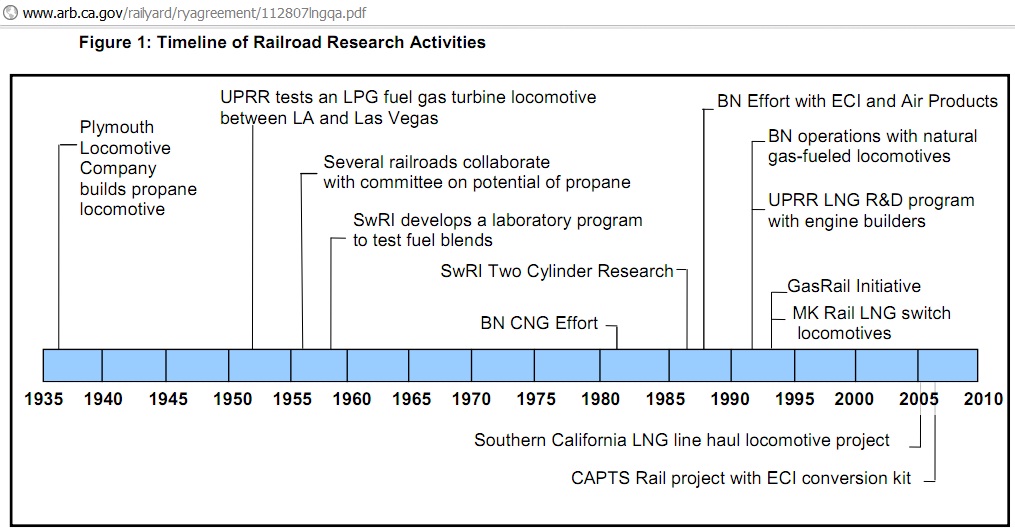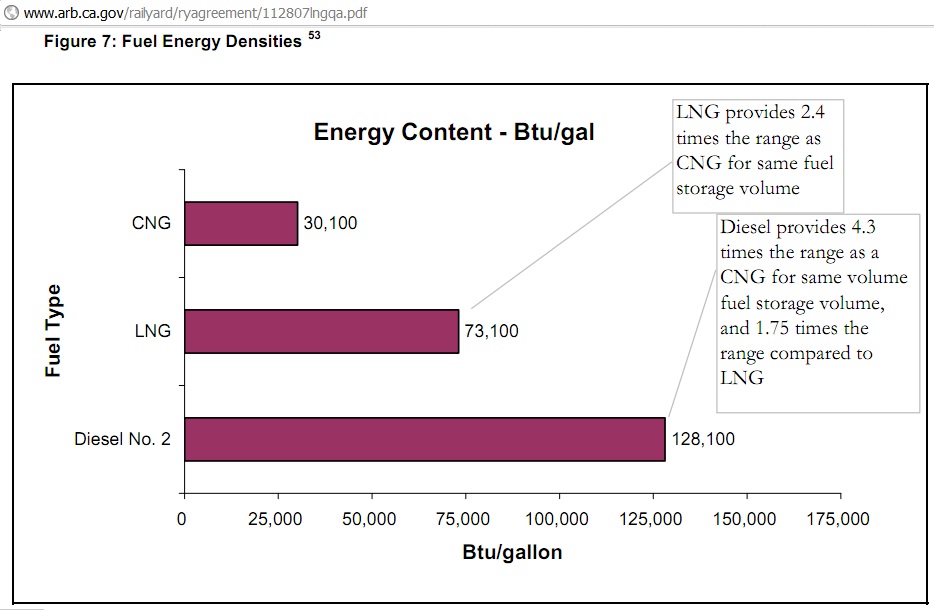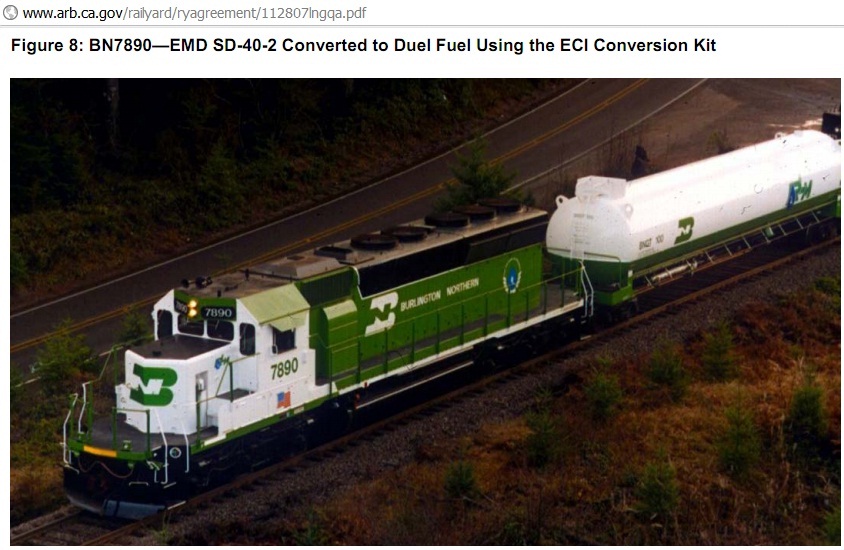It is very urgent to develop the use of alternative fuels in rail transport. Although rail electrification is the final solution, there is need for a transitional fuel.
http://www.energyconversions.com http://www.rrpicturearchives.net/Locopicture.aspx?id=12655
(1) The increase in fuel efficiency of diesel engines may not be enough to offset decline in the availability of diesel. For example a 5% fuel efficiency increase of the GE Evolution series (which will operate for decades) over the previous model is hailed as a success. However, global crude oil exports have declined by around 2% every year between 2005 and 2009 while crude oil production has stagnated. This export decline will accelerate as crude production is set to fall off its current production plateau
(2) There will be physical diesel shortages in the next years depending on how fast Arab unrest – in part triggered by the impacts of peak oil – spreads to main oil exporters in the Middle East
(3) The existing loco fleet must be used.
Australia has sufficient natural gas reserves for the purpose of replacing oil but LNG is exported instead of being used as a transport fuel (wrong energy and transport fuel policy). The timeline required to do the necessary conversions and build up the associated infrastructure dictates that a natural gas conversion program is started immediately.
In November 2010 the Australian Rail Association has proposed to initiate a joint research and development program into the use of natural gas in Australian locomotives but this is considered to be for the long term only(see link below). A 10-year program to replace and repower aging locomotives is seen as short-term. A re-definition of these timelines is absolutely essential.
Here are some extracts from a US study:
An Evaluation of Natural Gas-fueled Locomotives
November 2007
 This bar chart shows how long it takes to develop technologies.
This bar chart shows how long it takes to develop technologies.
The overall 2.1% to 2.3% yearly gains since 1980 have been impressive, but recent data show a decrease in the annual percentage of improvement. For the period 2001 to 2004, the overall improvement is 1.7% or about 0.56% per year. p. 20
Burlington Northern Effort with ECI and Air Products (1987 – 1992)
In 1987, the Burlington Northern Railroad began a two pronged effort to develop natural gas fueling infrastructure and line-haul locomotives capable of running on natural gas. For the fueling infrastructure, the Burlington Northern worked with Air Products and Chemicals to develop fueling locations and cryogenic tank tender rail cars to support the use of Refrigerated Liquid Methane (RLM), a high purity form of liquefied natural gas, as a locomotive fuel.
 A fueling station was constructed in Staples, MN. A cryogenic tank was designed, parts of it extensively tested, and two 25,000 gallon RLM tender cars were manufactured. For the locomotives, the Burlington Northern Railroad and Air Products and Chemicals worked with ECI to convert two 3,000 hp EMD SD40-2 locomotives (engine model 16-645E3B) to run in a dual fuel mode.
A fueling station was constructed in Staples, MN. A cryogenic tank was designed, parts of it extensively tested, and two 25,000 gallon RLM tender cars were manufactured. For the locomotives, the Burlington Northern Railroad and Air Products and Chemicals worked with ECI to convert two 3,000 hp EMD SD40-2 locomotives (engine model 16-645E3B) to run in a dual fuel mode.
This engine conversion kit utilized a low pressure gas injection system which provided compression ignition of the fuel using diesel fuel as the pilot ignition source. For some engine conditions – start, idle, and low notch settings – the locomotive operated exclusively on diesel fuel. The locomotive could also operate in a 100% diesel mode in all notches if required. For natural gas fuel delivery, the RLM passed through a vaporizer on the tender car and was piped to the locomotive and injected into the cylinder as gaseous methane under relatively low pressures (85-125 psi).
http://www.arb.ca.gov/railyard/ryagreement/112807lngqa.pdf
—————
Transport Canada
Program definition study for feasibility of a natural gas locomotive demonstration program
2002
http://www.tc.gc.ca/eng/innovation/tdc-projects-rail-e-9828-1211.htm
Other links:
GE Transportation and UGL signed a series of agreements for the sales and distribution of locomotives and associated technology and services in Australia. The Evolution Series Locomotive is the most technologically advanced heavy haul locomotive in the world, making it an ideal product for hauling iron ore and other bulk commodities throughout Australia. It is 5% more fuel-efficient and generates 40% lower emissions than previous locomotives.
GE Transportation has delivered 56 locomotives to Australian companies including Rio Tinto and Pacific National since the start of 2008. Approximately 500 locomotives from GE Transportation and UGL are currently in use throughout the country.
ARA’s proposals
November 2010
Short-Term:
Replace or Repower Locomotives In the short term the industry proposes a ten-year program of repowering and/or replacing up to 183 of Australia’s worst performing locomotives. Most of these locomotives are in desperate need of replacement; however they are most likely a legacy narrow gauge locomotive or operating on a loss-leading line where the business case for a new locomotive is not viable. This program would cost between $424 million and $721 million, reduce emissions for various pollutants by 20-80 percent of each replaced locomotive, create jobs in regional areas and is likely to contribute to improving the health of many Australians.
Long-Term:
Natural Gas for Rail
In the longer term, the industry proposes a joint research and development program into the use of natural gas in Australia’s locomotives. This program would focus on developing solutions to utilise natural gas as a primary alternative fuel in high powered and well-utilised locomotives. Natural gas is much cleaner than diesel. Australia also has a very large supply of natural gas. This development program is likely to cost approximately $37 million over five years. Using our supply of natural gas would reduce emissions, increase energy security and assist in developing a globally unique centre of excellence.
http://www.ara.net.au/UserFiles/file/Publications/EnvironmentalSolutionsforRail_Summary.pdf
.


